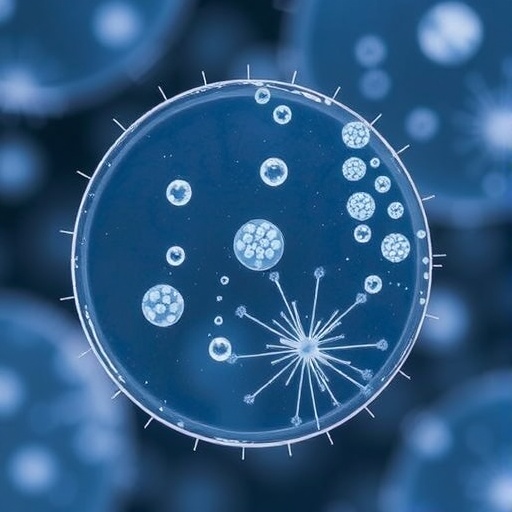In recent years, the proliferation of plastic pollution has emerged as one of the most pressing environmental challenges confronting marine ecosystems worldwide. Among the myriad types of plastics contaminating our oceans, polypropylene (PP) and polylactic acid (PLA) have drawn particular scrutiny due to their widespread use and divergent environmental fates. A groundbreaking new study published in Microplastics & Nanoplastics now reveals compelling evidence that leachates from weathered polypropylene items exert significant ecotoxicological effects on marine diatoms, while similar leachates from polylactic acid do not invoke such adverse impacts. This nuanced distinction underscores the complex interactions between plastic composition, degradation processes, and marine life toxicity.
The study, spearheaded by Niu, Segura, Gall, and colleagues, delves into the toxicological consequences of leachates—chemical substances that seep out from plastics as they break down in marine environments. Polypropylene, a versatile polymer widely used in packaging, textiles, and containers, undergoes weathering when exposed to sunlight, water, and mechanical abrasion. This weathering process leads to the release of a cocktail of organic and inorganic compounds into seawater, raising urgent questions about their biological effects, particularly on primary producers like marine diatoms.
Marine diatoms, microscopic photosynthetic algae, form the cornerstone of oceanic food webs and are integral to global carbon cycling. Their sensitivity to chemical stressors is a crucial indicator of ocean health. The research team employed controlled laboratory conditions to simulate weathering of polypropylene and polylactic acid materials, subsequently collecting leachates for ecotoxicological testing on a representative marine diatom species. The experimental design allowed precise quantification of growth inhibition, photosynthetic efficiency impairment, and cellular damage, furnishing a comprehensive toxicity profile.
Results demonstrated that leachates derived from aged polypropylene items caused pronounced deleterious effects on diatom populations. Even at low concentrations, these leachates inhibited algal growth rates, reduced chlorophyll content, and disrupted photosystem II efficiency—key parameters indicative of compromised photosynthetic capacity and vitality. In stark contrast, leachates from weathered polylactic acid, a biopolymer touted for its biodegradability, appeared inert with respect to these endpoints, signaling negligible ecotoxicological risk under equivalent conditions.
Mechanistic investigations suggest that the distinct chemical compositions and degradation pathways of polypropylene versus polylactic acid underpin their differential toxicity. Polypropylene’s polymer chains undergo oxidative cleavage during weathering, generating low-molecular-weight organic compounds, including aldehydes, ketones, and carboxylic acids. These substances, often hydrophobic and bioactive, can penetrate diatom cell membranes, triggering oxidative stress and metabolic disruption. Meanwhile, polylactic acid primarily hydrolyzes into lactic acid and related metabolites, which are relatively benign and readily assimilated by microbial communities without inducing cellular damage in primary producers.
This study is a critical advancement in understanding the nuanced ecological ramifications of plastic pollution. While biodegradable alternatives like PLA are increasingly promoted to mitigate plastic waste, this evidence confirms that not all plastics are equal in their environmental interactions. Polypropylene’s persistence and chemical leachate profile pose a tangible threat to foundational marine microorganisms, potentially cascading through trophic levels and impairing ecosystem services.
Further implications extend to policy frameworks seeking to curb plastic pollution and implement sustainable materials. The differentiation between traditional fossil-fuel-based plastics and bioplastics should inform regulatory approaches, especially those targeting marine litter management and pollution abatement strategies. This research advocates for prioritizing the reduction of polypropylene waste inputs and encourages investment in comprehensive life-cycle assessments for emerging polymer technologies.
Moreover, these findings open new avenues for ecotoxicological monitoring and risk assessment of plastic-derived contaminants. Traditional studies often focus on physical impacts such as ingestion or entanglement, but chemical leachates represent an underexplored dimension of plastic pollution toxicity. Developing sensitive bioassays employing ecologically relevant species like marine diatoms offers a robust platform for early detection of sublethal effects that could affect population dynamics and ecosystem resilience.
The work by Niu and colleagues also underscores the need for interdisciplinary collaboration integrating polymer chemistry, marine biology, and environmental toxicology. Detailed characterization of leachate chemical profiles, coupled with mechanistic studies on cellular pathways disrupted in diatoms, will refine predictive models of ecological risk associated with plastic debris. Additionally, expanding research to encompass a broader array of microalgal species and environmental conditions will enhance the generalizability of results.
On a broader ecological scale, marine diatoms contribute approximately 20% of global primary productivity, rivaling terrestrial rainforests in carbon fixation. Their impairment by plastic-derived leachates could thus have profound consequences for oceanic carbon sequestration, biogeochemical cycles, and ultimately climate regulation. Such indirect impacts highlight the interconnectedness of plastic pollution with global environmental sustainability challenges.
Importantly, this research presents a timely reminder that innovation in material science must be coupled with rigorous ecological evaluation. Bioplastics like PLA, while promising, are not a panacea, and ongoing monitoring of emerging pollutants remains essential. The study advocates for adopting a precautionary principle approach in plastic production and waste management, emphasizing prevention over remediation of environmental harm.
In conclusion, the study conveys a compelling narrative of how weathered polypropylene leachates compromise the health and function of marine diatoms, pivotal architects of the ocean’s ecological machinery. The absence of similar effects from polylactic acid contributes to a nuanced understanding of plastic pollution’s heterogeneity, inspiring more targeted and effective environmental policies. As marine ecosystems grapple with mounting anthropogenic pressures, such integrative research forms the backbone of informed stewardship and sustainable ocean management.
Subject of Research: Ecotoxicological effects of leachates from weathered polypropylene and polylactic acid on marine diatoms
Article Title: Leachates from weathered polypropylene items, but not from polylactic acid, induce ecotoxicological effects on a marine diatom
Article References:
Niu, Z., Segura, S.A., Gall, M.L. et al. Leachates from weathered polypropylene items, but not from polylactic acid, induce ecotoxicological effects on a marine diatom. Micropl.&Nanopl. 5, 35 (2025). https://doi.org/10.1186/s43591-025-00143-8
Image Credits: AI Generated
Tags: chemical substances from weathered plasticsdegradation processes of polypropyleneecological interaction between plastics and marine lifeecotoxicological effects of plasticsenvironmental challenges of plastic wasteimplications of plastic composition on toxicitymarine primary producers and plasticsmicroplastics and diatom healthplastic pollution marine ecosystemspolylactic acid environmental impactpolypropylene leachates marine diatoms toxicityresearch on plastic pollution effects





